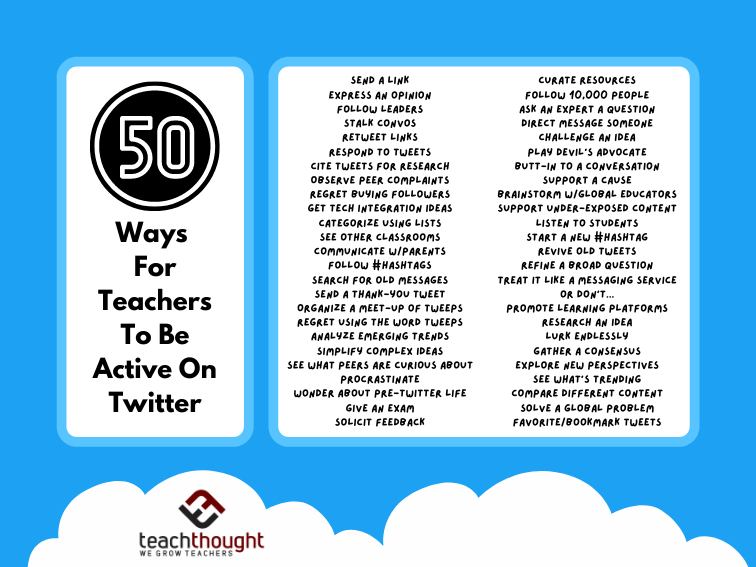
50 Ideas For Teachers To Be Active On Twitter
by TeachThought Staff
This post has been updated and republished from a 2013 post.
Send a link.
Express an opinion.
Follow innovative thought leaders.
Stalk conversations between people you respect.
Retweet a helpful link.
Respond to someone else’s tweet.
Have students use a tweet in a research project, then cite it using MLA rules.
See what your peers are complaining about.
Buy 5000 followers for $5, then wonder what on earth you’ve done.
Get ideas for technology integration.
Categorize twitter accounts by content using lists.
Send a picture of your classroom with twitpic.
Ask for pictures of other classrooms.
Communicate with parents.
Follow a twitter chat via #hashtag.
Search for older messages (old = last week or so) to gauge “what educators are saying” about a particular topic–#21stedchat, for example. Or rather, what they were saying last week.
Thank someone for their time, content, or collaboration.
Organize a local-ish meet-up of local tweeps.
Commit to never using the word tweeps again.
Analyze emerging trends.
Try to understand a complex idea by capturing it entirely in 140 characters. (Go on, try it.)
See what your peers are curious about.
Procrastinate when you should be researching, writing, grading, or planning. After all, twitter is research.
Wonder what the world was like before twitter.
Give an exam by asking open-ended questions which must be then revised, refined, and articulated in the very transparent domain of twitter.
Encourage mentors or PLN members to observe and chime-in to said “open” exam with feedback.
Curate resources by clicking relevant links, then saving with Evernote, pocket, Pearltrees, or another social bookmarking tool.
Follow 10,000 people just to watch the absolutely ridiculous stream of tweets pour down your screen like a crazy digital waterfall.
Ask an expert a question with @ messaging.
Direct message someone a “hand-typed” (as opposed to automated) message as a show of support.
Challenge an idea.
Play devil’s advocate.
Butt-in to a conversation that has nothing to do with you, and be abrasive about it. (Watch your follow count drop, and be sure grin devilishly when you get blocked.)
Support a cause.
Brainstorm with global educators to solve a local problem.
Brainstorm with local educators to solve a global problem.
Give exposure to under-exposed content.
Listen to students.
Start a new #hashtag.
Revive “old” tweets worth revisiting.
Start with a broad question, then collaboratively refine it until you’ve gotten at the right question. (This can be done with students or other educators.)
Treat twitter like a personal text message service full single words and initialisms, e.g., “LOL!” and “IKR!” to one person.
Or don’t.
Promote your favorite learning platform by explaining how educators might use it.
Research an idea.
Lurk endlessly.
Gather the general consensus on an issue.
Read tweets from the perspective of new audiences—what would parents, politicians, students, business leaders, etc., think of tweeted edu-content.
Watch what is “trending” when, and why.
Pay attention to the differences in content that gets shared via RT, favorited, and responded to.